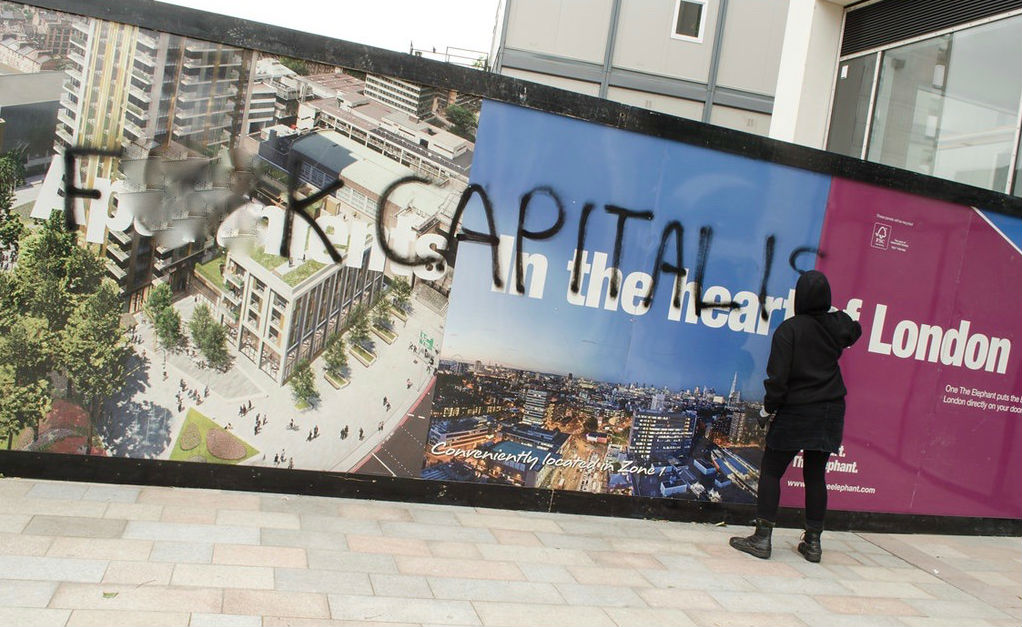 Anticapitalist graffiti on march against austerity, 2015. Photo: Flickr/luke forsythe
Anticapitalist graffiti on march against austerity, 2015. Photo: Flickr/luke forsythe
As more young lives are being tragically lost to knife crime, we must demand an end to austerity and investment in our communities, the very opposite of the Tories response of racism and repression, argues Julie Al-Hinai
It seems not a weekend passes without tragic news of the murder of yet another young person, devastating families and communities. What has been the response of our politicians and the media?
Drill music, social media, gang culture and drug running have all been blamed. If we believe the headlines, knife crime is at an all-time high, it’s almost exclusively a “black on black crime”, it’s the capital’s problem and it might even be time to “call in the army”. Stop and search must be stepped up, along with tougher sentences for offenders. The government have been desperately blaming anything but the effects of nearly a decade of austerity.
But factors such as gang warfare, drug running and drill music are more likely to be a response to inequality, marginalisation and persisting institutional racism. It is amongst this response that crime becomes a way of life. Perhaps the only way.
A quick look at the statistics throws up some surprises. Agreed, knife crime homicides have risen consistently over the last 40 years: from 272 deaths in 2007, where except for a drop to 186 in 2015, they reached a record 285 lost lives in 2018. Without distracting from the tragedy of any one lost life, last year’s record levels of knife violence saw 13 more violent deaths than 11 years earlier. However, this is a significant increase on the pre-Thatcherite, 1977 figures of 142 deaths by the knife. Interestingly, 75% of the 2018 knife homicides were committed outside of London. Only 1 in 4 involved young men aged 18-24, and 75% of those affected were not black, despite the discourse suggesting differently.
But the media coverage of knife crime is deeply derisive, pointing the blade at black youth. It works to spread fear, not only among the young themselves but in society as a whole. This leads to suggestions and acceptance that by increasing police powers, building more prisons and privatising probation services it will work to save us from this scourge.
This approach performs ideological functions for the ruling class. To then racialise this violence does little other than perpetuate social exclusion and distract from the root cause.
All classes, not just the working class, commit crime, and the crimes of the capitalist class are more economically costly than street crime. While knife crime comes under the media spotlight, it is rarely considered significant to comment on the fact it is class-based sufferance; rather it is presented as an ethnic minority affliction on society.
High density urban areas are more deeply divided than ever – spatially, economically and culturally and knife crime is mostly a feature of such localities. They have progressively become spaces where colossal inequality exists between the powerful and those who suffer poverty, injustice, systemic and institutionalised racism. In London these high-density areas are predominantly populated by black and other ethnic minorities. Knife crime is thus prevalent in the black population. In other whiter conurbations, it is a crime committed by white people and just as prevalent, if not more so. To racialise this violence criminalises a whole race and is convenient to the agenda of the police in bringing back racially-profiled stop and search; the icing on the cake of the generalised oppression of poorer communities. It breeds intense anxiety, suspicion, and hatred among the new generation.
Even though as long back as 1981, David Robbins wrote in his book Tarnished Vision: Crime and Conflict in the Inner City,
The fact is that the incidence of persistent patterns of criminality is a measure of the extent of the failure of the community, its leaders, and its organizations to meet the hopes of young people. When hopes are wasted, and there is little sense of co-operation, people prey upon each other, and children are condemned to grow up in a social nightmare.
And what hope can we offer these young people almost 40 years on? The neoliberal age has seen wholescale de-industrialisation of our cities, taking with it any prospect of an honest day’s work for an honest day’s pay. Globalisation and the financialisation of the city commodifies urban space and leads to huge disparities of wealth and opportunity. The privatisation and cuts to social services, including education and housing, remove any safety nets. The record levels of school expulsions and cuts to early intervention and youth services are indicative of the conscious cruelty of austerity measures. It is these neoliberal, capitalistic practices that are the root cause of producing “difficult to educate” and “hopeless” (in its literal meaning), young people that resort to killing each other with blades on the streets of our cities.
Life in inner-city neoliberal Britain provides just such a model. So, we need to bring about a new and inclusive society, rooted in the realisation of hope, equality of opportunity and just reward. For this we need deep, structural changes, not glib scapegoating. We need to end austerity and invest in our communities, re-open the closed youth centres and build more, and fund social work. We need to end the academisation of our education system which has led to an increase in pupil exclusions and we need more support staff in schools. We need to see an end to the despair and hopelessness generated by Universal Credit, insecure, poorly-paid and casualised jobs, and insecure and unaffordable housing. This is what we need if we are stop young lives being lost to street violence.

